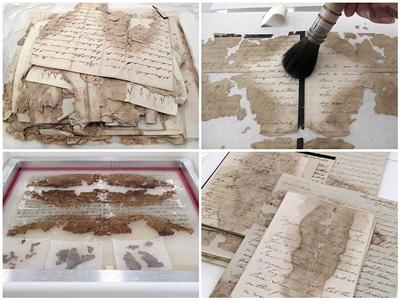The Wellington Papers came to Southampton with a major challenge of conservation: some ten percent of the collection was so badly damaged it was unfit to handle and 10,000 documents were in a parlous condition. The University has made good progress: about seventy percent has been conserved and is now available for research, including papers for 1822 (for the Congress of Verona), for Wellington as Prime Minister in 1829 (the year of Catholic emancipation), and for some of the Peninsular War.
A campaign to raise funds for the conservation of the Wellington Papers was launched in October 2010. Grants from the National Manuscripts Conservation Trust, the J.Paul Getty Jr Charitable Trust and the Rothschild Foundation as well as modest funding from alumni supported the conservation of the badly degraded and mould-damaged papers from 1832, which is described in this article. A current project, jointly funded by the Foyle Foundation and the University and appropriate for the bicentenary of Waterloo, is focussed on the military papers for 1815.

The conservators began by working with the less severely damaged materials for 1832 to enable them to develop expertise in conserving this type of exceedingly fragile material before tackling the most fragmentary bundles.
Documents were fully documented before separation. Tests carried out before treatment included fibre analysis, chemical spot tests, pH tests to determine acidity, mechanical rub tests for surface cleaning, examination under optical microscopes and UV light and tests to determine ink solubility and the extent of iron gall ink corrosion.
Papers were separated manually and collated. Separation, particularly of the most severely damaged bundles, is a painstaking and time-consuming task. In some instances papers have fused together due to compression whilst damp and great care is necessary to prevent disintegration of the paper.
Surface cleaning was undertaken where possible and where necessary individual items were given aqueous treatments, including washing supported on non-woven polyester on silk screens in cold and warm water to remove discolouration and soluble degradation products, calcium phytate treatment to stabilise iron gall ink corrosion and deacidification with calcium hydrogen carbonate. Fragments were washed alongside documents either loose or within non-woven polyester pockets. These were then realigned with the original which was lined to hold all fragments in place during the repair procedure.
The documents were repaired by leafcasting similarly toned paper pulp consisting of a blend of cotton and hemp fibres. The conservators have created a reference tool of differently toned papers that match the papers within the collection. Griffin Mill Papermakers produced a special making of handmade paper to our specification.
After humidification, pressing and resizing where necessary, documents were refolded and stored in custom made four flap folders and acid free boxes. Any fragments that could not be identified were noted, housed in melinex pockets and stored alongside the documents. Photographic documentation was made of all the processes.
To date most of the bundles of documents have been conserved using leaf casting and paper pulp repair. The expertise gained by the conservators has enabled them to concentrate on the most fragile items with work underway on the separation and stabilisation of the final 6 bundles. These present some of the most severe conservation challenges as the separation of fragmented material can take several months to complete before any treatment is possible.
Many of the fragmented bundles for 1832 are now accessible for the first time since the 1940s. This is historically very significant material as it includes the first Duke of Wellington’s papers relating to the first Reform Act. As Wellington was the leader of the Tories in the House of Lords during the progress of the Act, by enabling archivists to access and catalogue the material, the whole picture of the debate now will be available.
October 2015
Links to external websites
The University cannot accept responsibility for external websites.